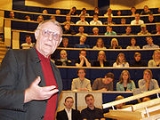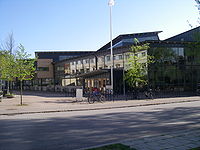
Linnaeus University
Encyclopedia

University
A university is an institution of higher education and research, which grants academic degrees in a variety of subjects. A university is an organisation that provides both undergraduate education and postgraduate education...
in the Småland
Småland
' is a historical province in southern Sweden.Småland borders Blekinge, Scania or Skåne, Halland, Västergötland, Östergötland and the island Öland in the Baltic Sea. The name Småland literally means Small Lands. . The latinized form Smolandia has been used in other languages...
region of Sweden
Sweden
Sweden , officially the Kingdom of Sweden , is a Nordic country on the Scandinavian Peninsula in Northern Europe. Sweden borders with Norway and Finland and is connected to Denmark by a bridge-tunnel across the Öresund....
. It has two campuses, one in Växjö
Växjö
Växjö is a city and the seat of Växjö Municipality, Kronoberg County, Sweden with 64 200 inhabitants in 2010. It is the administrative, cultural and industrial centre of Kronoberg County. Furthermore it is the episcopal see of the Diocese of Växjö. It has a population of about 64 200, out of a...
and one in Kalmar
Kalmar
Kalmar is a city in Småland in the south-east of Sweden, situated by the Baltic Sea. It had 62,767 inhabitants in 2010 and is the seat of Kalmar Municipality. It is also the capital of Kalmar County, which comprises 12 municipalities with a total of 233,776 inhabitants .From the thirteenth to the...
. Linnaeus University was established in 2010 by a merger of former Växjö University and Kalmar University College (Swedish: Högskolan i Kalmar), and has been named in honour of Carl Linnaeus.
History
Växjö University was initially a department of Lund UniversityLund University
Lund University , located in the city of Lund in the province of Scania, Sweden, is one of northern Europe's most prestigious universities and one of Scandinavia's largest institutions for education and research, frequently ranked among the world's top 100 universities...
that was founded in 1967 in Växjö. In 1977 this department became an independent university college
University college
The term "university college" is used in a number of countries to denote college institutions that provide tertiary education but do not have full or independent university status. A university college is often part of a larger university...
. The college was then granted university status by the Government of Sweden
Government of Sweden
The Government of the Kingdom of Sweden is the supreme executive authority of Sweden. It consists of the Prime Minister and cabinet ministers appointed by the Prime Minister. The Government is responsible for their actions to the Riksdag, which is the legislative assembly...
in 1999.
Kalmar University College was a högskola
Högskola
A university college denotes an independent institution in Sweden and Norway that provides tertiary education and in limited cases also quaternary education...
founded in 1977. Since 1999 it had been entitled to issue doctoral degrees in the natural sciences.

The Symbol
The symbol consists of a stylized tree. The origin is a Linnaeus drawing taken from his "Örtabok". While the tree is said to be a symbol for the month of May and to represent the power of growth, it also symbolize LNU's ambition to be a global university with the region as its base and the world as its arena.Faculties
- Faculty of Health, Social Work and Behavioural Sciences.
- Faculty of Humanities and Social Sciences.
- Faculty of Business, Economics and Design.
- Faculty of Science and Engineering.
- Board of Education Science.
Schools
- School of Health and Caring Sciences.
- School of Education, Psychology and Sport Science.
- School of Social Work.
- School of Language and Literature.
- School of Cultural Sciences.
- School of Social Sciences.
- School of Business and Economics.
- School of Design.
- School of Natural SciencesSchool of Natural SciencesThe "School of Natural Sciences" within the Linnaeus University is part of the Faculty of Science and Engineering. Scientists working at the school are involved in research and teaching activities in Biology, Biomedical Science, Pharmacy, Chemistry, Food Science, Environmental Science, Optometry...
. - School of Engineering.
- Kalmar Maritime Academy.
- School of Computer Science, Physics and Mathematics.
Other institutes
- School of Education.
- Institute of Police Education.
- Institute for Further Education of Journalists.
Other departments
- Communications Department.
- Department of Buildings and Services.
- Department of External Contacts.
- Department of Planning.
- Department of Student Affairs.
- Faculty Office.
- Finance Department.
- International Relations Office.
- IT Department.
- Office of Teacher Education and Educational Science.
- Personnel Department.
- Rector's Office.
- University Library.
Linnaeus In Figures
- 34 000 students
- 15 000 full-time students
- 2000 employees
- 138 training
- 100 subjects , including 67 exam subjects
- 1500 million in sales of which 350 million research / research
Kalmar
Kalmar is a medium-sized town, with ideal settings for student life. The town is attractive and conveniently laid out, with a colorful history and a castle dating back to medieval times, close proximity to the sea, undulating farmlands and deep forests. The School of Natural Sciences in Kalmar has special competence in the area of life, health and the environment and is recognized for excellence in teaching and research across a range of natural sciences and related disciplines. The School offers Master’s programmes which equip the graduate for work in industry or future studies towards a PhD. However, the student life in Kalmar has recent been partly worked against by the local authorities. For example, the only nigh club for students in Kalmar, Core House, was closed due to a rent chock from the owner, Kalmar Kommun.Växjö
Växjö, is a central community in southeastern Sweden, with a full range of cultural and musical life in its many museums, theaters, cathedrals and concert halls. The area is known as the Kingdom of Crystal since world class glassworks such as Kosta Boda and Orrefors are located here. The House of Emigrants commemorates the great emigration epoch from 1850 to 1930, when 1.3 million Swedes emigrated to America. The region is also known for its high tech industry, pulp and paper manufacturing, and home of the furniture manufacturer, IKEA. The surrounding pristine lakes and forests are an attraction for those who love wildlife and the outdoors. Växjö is also one of the leading tennis cities in the world as Mats Wilander, Stefan Edberg, Magnus Larsson and Jonas Bjorkman have all trained and played here. Växjö is easily accessible from Copenhagen and Stockholm by plane and train.The campus is located just outside of Växjö
Växjö
Växjö is a city and the seat of Växjö Municipality, Kronoberg County, Sweden with 64 200 inhabitants in 2010. It is the administrative, cultural and industrial centre of Kronoberg County. Furthermore it is the episcopal see of the Diocese of Växjö. It has a population of about 64 200, out of a...
city center. It was modelled after the American Campus style, meaning that all teaching premises are within walking distance. The campus was built with the environment in mind, as it is bordering a nature conservation area.
There are 3,700 student apartments and dorm rooms on the university campus housing approximately 4,600-5,200 students. A part of the university campus is dedicated to the Videum Science Park. The park gives space to over 100 companies, thus being in close proximity with the university and encouraging innovation and research. The university also has student housing on Seminarievägen located in Växjö city center.
Teaching premises and accommodation stand side by side on the campus. There are also restaurants, cafés, bars, bookshops, a sports centre and a variety of service facilities. The campus offers a safe, relaxed environment despite the high level of activity. It is bordered by meadows, a nature conservation area, a lake with bird-watching towers and a castle
Teleborg Castle
The Castle of Teleborg is beautifully situated near the lake Trummen, 4–5 km south of the city centre of Växjö, Sweden.Despite its middle-age style, the castle was built in 1900 by architect firm Lindvall & Boklund. The castle was built as a wedding present from count Fredrik Bonde af Björnö...
.
New buildings have been erected with due concern for the environment, leaving room for old trees and moss-covered boulders among the new architecture on campus. Cars have only limited access to the site, but cycle paths lead directly to the town centre and out into the beautiful countryside all around.
VIS
VIS standsfor Växjö International Students. It is a non-profit organisation, and a local section of ESN Sweden.The board and its community consist of students that use their own spare time to create activities for all exchange students, and to give them a positive experience of Växjö.
External links
- Linnaeus University - official site
- VIS - official site
- Master Of Science

